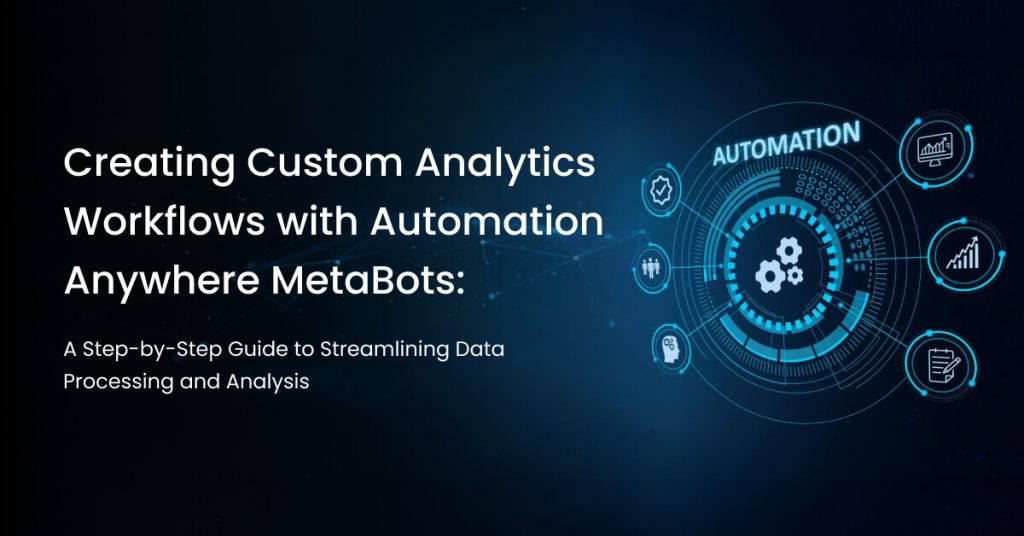
Data processing has perpetually consumed significant time for organizations seeking insights to propel growth and business. It stands as an essential process that cannot be disregarded, given that data serves as the contemporary currency upon which organizations heavily rely for,
- Capturing trends
- Analyzing customer preferences
- Investing in new and revolutionary innovations
With so much scope to offer businesses, data processing, and analytics need meticulous attention from data scientists and other professionals while handling them. Also, as business operations expand, data starts streaming from diverse sources that can be structured, unstructured, or semi-structured challenging organizations to work on the quality and integrity of data.
A compromise on data quality and integrity leads businesses to totally succumb to penalties and reputational losses. To combat all this and help professionals focus on higher tasks, leaning towards analytic process automation can be an ideal practice. The reliance on automation for data processing and analytics assists businesses of all sizes to
- Manage large volumes of data generation efficiently and effectively
- Eliminate repetitive manual tasks of lower importance.
- Increase accuracy in quality, integrity, and compliance.
- Enhance the decision making process as automation enables rapid transformation of raw data into business insights.
Thus, the integration of analytic process automation in data analytics is increasing among organizations, which is in the interest of consumers and competitive advantages. This blog is a compilation of how a Metabot from Automation Anywhere will help in creating a workflow that assists in streamlining data processing and analytics.
What is Data Automation?
Data automation is the process of leveraging processes, software, and technology, like intelligent automation tools, to source a diverse range of data and drive quality insights that are of high business value. As a three step process that includes Extract, Transform, and Load (ETL),
Extract : Help extract data from streaming platforms, application logs, SQL queries, and other sources within the organization and store it in a centralized repository.
Transform : It is one of the main processes in data automation, where the data is aligned, modified, and enriched to offer businesses insights.
Load : In this stage, the data is loaded into the final system, where organizations can read its format. This stage generates all kinds of analysis and information.
Thus, the application of data automation via metabots empowers organizations to focus on strategic processes that can help them move further ahead. While robotic process automation services are end-to-end processes that automate repetitive, error-prone, and time-consuming tasks, metabots help create customized workflows for particular tasks through their pre-built and reusable components.
Why Use Metabots for Data Analytics?
Consistency : Well-known for its standardized components, Metabot’s application for a particular function remains the same across different projects. For example, a data extraction metabot developed for one project is reused for multiple projects seeking the same functionality. This consistency is what ensures the data analytics process remains error-free and reliable.
Customization : The ability to customize as per analytical requirements and use-cases makes Metabot ideal for streamlining data processing and analytics. For example, if you need to source data from an API, Metabot can be configured for such an extraction. Also, if you want to generate reports in PDF, Excel, or HTML, Metabot can be customized as per your business requirements. This type of flexibility and adaptability offered for data analytics workflows through Metabot increases the efficiency and effectiveness of data processing.
Scalability : As business operations expand, the volume of data generated increases, demanding seamless and efficient analytical requirements. To meet this demand, metabots are the perfect solution. For example, the latest advanced analytic technologies like machine learning, predictive analysis, and artificial intelligence are added to Metabot as per business requirements. Thus, scaling metabot capabilities ensures handling large volumes of data without compromising on quality or integrity.
Integration : The capability of metabots to be integrated with other analytic ecosystems helps organizations gain X-ray visibility into each process, determining the efficiency of the workflow. For example, Metabots can be integrated with data visualization tools, data warehouses, machine learning algorithms, and other components. For example, the data extracted from a source can be integrated with a data warehouse for storage and analysis purposes. This functionality of Metabots empowers organizations to streamline their workflow and automate tasks, saving time and effort.
Thus, the application of Metabots states that its utilization for data analytics is beyond measure, and it is high time organizations explore Metabots’ full potential in scaling business operations and driving insights.
The Guide for Creating Custom Analytics Workflows Using Metabots
Designing custom workflows that streamline data processing and analytics effectively with Metabot’s support will help organizations seamlessly handle data, store it, and visualize it to drive insights and make decisions. Here’s a simple guide that walks you through creating an analytics workflow, showing the impact your business is likely to achieve if implemented in the right way with the right consulting provider.
1. Determine the Analytical Requirements
Data processing involves a series of steps, like data extraction, data transformation, data cleansing, data storage, data visualization, and data generation. Identifying which series of data processing processes require automation should be an essential step in building a Metabot. For example, if you want to automate the data cleaning process, then the Metabot is designed with rules and criteria that help identify inconsistencies, errors, and other formats that don’t support any information. Also, the integration of Metabot with data storage repositories is essential. This emphasizes the necessity of establishing the analytical requirements in advance.
2. Calculate the Metabot Potential
Once the analytical requirements are established, it is time to choose the Metabot available within the Automation Anywhere platform. Analyze each and every Metabot present for its capability, integration functionality, and customization options. Make sure the Metabot is capable of
- Extracting data from various sources like APIs, databases, streaming platforms, and other sources.
- Performing necessary data transformation processes like cleaning, modeling, and storing.
- Generating reports in various formats.
This study on Metabot capability will help you understand its abilities and provide you with a clear idea of whether the chosen Metabot will support or align with your established requirements. If you feel the Metabot is still lacking a few functionalities, check its customization capabilities and extend them by tailoring them to your business requirements.
3. Define Workflow Architecture
Start by defining the aim of the workflow. Whether it is to drive insights, predict trends, or understand customer preferences, this will help sequence the logic of the workflow. Next, segment the analytics into smaller tasks like extraction, transformation, visualization and generation. This will help in considering the dependencies between each workflow. As a next step, identify the Metabot that will assist in each workflow process. Make sure to clearly define the input and output for each workflow task. The output generated should align with the intent of the automation process. Also, ensure that the dependencies are established and well executed with the mention of error-handling mechanisms.
Once this is done, identify the flow of data, result aggregation, and how they can be visualized for stakeholders. As a final step, document the workflow architecture and review its efficiency in meeting the objectives and requirements of workflow analytics.
4. Integrate the Selected Metabot
The chosen Metabot is all set to be integrated with the defined workflow. Specify the parameters that include the input scores, data formats, processing options, and output destinations. This makes sure the Metabot is aligned with the objective. Once the parameters are set, define the triggers and conditions that help in initiating the event and setting the time frame for each workflow, respectively. Also, mention the flow of data among the workflow components, which include the Metabot, data sources, transformation phase, and report generation. Then test the Metabot for its integration ability, along with the trigger, condition, and dependencies, without any lag or errors. Thus assisting organizations in the seamless execution and integration of Metabots.
5. Perform Advanced Analytics
The data generated is now subjected to various statistical analyses by the metabot to drive insights that deliver information for business decisions and organizational growth. Metabot performs the following functionality in driving through insights.
- Facilitates statistical analyses, including fitting regressions and calculating descriptive statistics, which uncover patterns, trends, and relationships among the data.
- Applies machine learning algorithms to the data for tasks such as clustering, classification, regression and anomaly detection. The potential to study historical data by machine learning algorithms extends a huge assistance for Metabots to predict outcomes, enabling organizations to automate decision-making processes.
- Fosters the development and deployment of predictive models that offer future forecasts. This is highly beneficial in sales, customer churn, and risk assessment processing, empowering organizations to have pre-data that is about to happen in the future.
This inclusion of advanced analytics further includes sentiment analyses, natural language processing, and time series analysis for a deeper understanding of data and its underlying information. This performance of advanced analytics with Metabots helps organizations harness the power of data and insights.
6. Test the Created Workflow
To verify the designed workflow, it is essential to test it with various conditions and combinations of use cases that include real-world scenarios, edge cases, and outliers. This helps the organization study the Metabot capabilities along with the workflow sequence. Verify the generated results with expected outcomes and pre-defined criteria that help validate the accuracy, reliability, and validity of the data. If any inconsistencies or errors are found, debug and fix the issue. Once debugged, iterate until no errors or lags are found in the workflow, Metabot, or configurations. Then, finally, validate the performance by measuring key metrics such as execution time, resource utilization, throughput, and scalability. Gather the results and present them to stakeholders, key executives, and other personnel for feedback to refine the workflow further and ensure that it meets user expectations and business requirements.
7. Deploy and Monitor
As the final process, the analytics workflow is transferred to the production environment to work on real-world data. The transformation ensures that all necessary components are integrated and configured, ensuring the workflow is ready to drive insights and help in decision making. The key metrics, which include time frame, accuracy, and resource utilization, are monitored for their performance. If any deviation is witnessed, it is taken into consideration and modified, resulting in continuous optimization until the business objectives are met without any compromise on workflow analytics and metabot capabilities.
Thus, the process of creating customized workflow analytics is well-stated. This ensures organizations reap the benefits of their data and drive excellent business decisions that help them scale operations and growth. This also emphasizes the integration of Metabots as a useful resource in the digital age, where customized and automated workflows take care of every step of the data processing process.
Why SquareOne Technologies?
While this blog serves as a guide to understanding the nuances and importance of MetaBots and other intelligent automation tools, practical implementation of the platform often requires the expertise of digital transformation companies like SquareOne Technologies. As prime partners of Automation Anywhere, SquareOne Technologies assists companies of all sizes in leveraging diverse automation services. Their seasoned experts specialize in helping businesses automate data processing using Automation Anywhere MetaBots, customizing rules, and criteria to align with specific business objectives. From consultation to deployment and monitoring, SquareOne Technologies accompanies businesses at every step of their data automation journey!
Conclusion
The guide underscores the growing significance of automation, highlighting its role in relieving organizations from routine, repetitive, and time-consuming tasks. This shift towards automation promises a more productive and efficient work environment, ultimately contributing to the organization’s bottom line. With Automation Anywhere MetaBots, organizations can develop tailored analytics solutions that are efficient, dependable, and scalable, empowering them to make informed decisions and succeed in today’s data-driven environment. Embracing automation and leveraging MetaBots, with support from SquareOne Technologies, enables organizations to unlock new opportunities, boost efficiency, and maintain a competitive edge in the modern business landscape.
Get started today by booking a demo with the team to learn more about Metabots and its significance for your business.


















